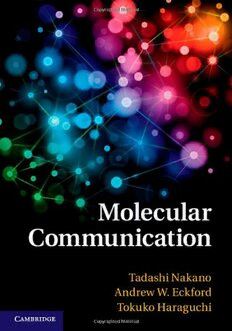
Molecular Communication PDF
Preview Molecular Communication
MolecularCommunication This comprehensiveguide, by pioneersin the field, brings together,for the first time, everything a new researcher, graduate student or industry practitioner needs to get startedinmolecularcommunication.Writtenwithaccessibilityinmind,itrequireslittle backgroundknowledge,andprovidesadetailedintroductiontotherelevantaspectsof biologyandinformationtheory,aswellascoverageofpracticalsystems. The authors start by describing biological nanomachines, the basics of biological molecular communication, and the microorganisms that use it. They then proceed to engineered molecular communication and the molecular communication paradigm, with mathematical models of different types of molecular communication, and a description of the information and communication theory of molecular communica- tion. Finally,the practicalaspectsof designingmolecularcommunicationsystems are presented,includingareviewofthekeyapplications. Idealforengineersandbiologistslookingtogetupto speedonthecurrentpractice inthisgrowingfield. TadashiNakano isanAssociateProfessorintheGraduateSchoolofEngineering,Osaka University,Suita,Japan.Hehasauthoredorco-authoredaseriesofpapersonmolecular communication,includingtheveryfirstpaper,publishedin2005. AndrewW.Eckford isanAssociateProfessorintheDepartmentofElectricalEngineer- ingandComputerScienceatYorkUniversity,Toronto,Canada.Hehasauthoredover 50papersinthepeer-reviewedliterature,andreceivedtheAssociationofProfessional EngineersofOntarioGoldMedal. TokukoHaraguchi isanExecutiveResearcherintheAdvancedICTResearchInstituteat theNationalInstituteofInformationandCommunicationsTechnology(NICT),Kobe, Japan,andaProfessorwiththeGraduateSchoolofScienceandtheGraduateSchoolof FrontierBiosciencesatOsakaUniversity,Suita,Japan.Shehasauthored100papersin biologicalresearch. UniversityPrintingHouse,CambridgeCB28BS,UnitedKingdom PublishedintheUnitedStatesofAmericabyCambridgeUniversityPress,NewYork CambridgeUniversityPressinpartoftheUniversityofCambridge. ItfurtherstheUniversity’smissionbydisseminatingknowledgeinthepursuitof education,learningandresearchatthehighestinternationallevelsofexcellence. www.cambridge.org Informationonthistitle:www.cambridge.org/9781107023086 (cid:2)c CambridgeUniversityPress2013 Thispublicationisincopyright.Subjecttostatutoryexception andtotheprovisionsofrelevantcollectivelicensingagreements, noreproductionofanypartmaytakeplacewithoutthewritten permissionofCambridgeUniversityPress. Firstpublished2013 AcataloguerecordforthispublicationisavailablefromtheBritishLibrary LibraryofCongressCataloguinginPublicationdata Nakano,Tadashi,1912– Molecularcommunication/TadashiNakano,AndrewW.Eckford. pages cm Includesbibliographicalreferencesandindex. ISBN978-1-107-02308-6(hardback) 1. Molecularcommunication(Telecommunication) 2. Molecules. 3. Nanotechnology. I. Title. TK5013.57.N352013 (cid:3) 620.5–dc23 2013009571 ISBN978-1-107-02308-6Hardback CambridgeUniversityPresshasnoresponsibilityforthepersistenceoraccuracyof URLsforexternalorthird-partyinternetwebsitesreferredtointhispublication, anddoesnotguaranteethatanycontentonsuchwebsitesis,orwillremain, accurateorappropriate. Molecular Communication TADASHI NAKANO OsakaUniversity,Suita,Japan ANDREW W. ECKFORD YorkUniversity,Toronto,Canada TOKUKO HARAGUCHI AdvancedICTResearchInstitute,NationalInstituteofInformationand CommunicationsTechnology(NICT),Kobe,Japan Contents Preface page xi 1 Introduction 1 1.1 Molecularcommunication:Why,what,andhow? 1 1.1.1 Whymolecularcommunication? 1 1.1.2 Whatusesmolecularcommunication? 2 1.1.3 Howdoesitwork?Aquickintroduction 3 1.2 Ahistoryofmolecularcommunication 6 1.2.1 Earlyhistoryandtheoreticalresearch 6 1.2.2 Morerecenttheoreticalresearch 8 1.2.3 Implementationalaspects 9 1.2.4 Contemporaryresearch 9 1.3 Applicationsareas 11 1.3.1 Biologicalengineering 11 1.3.2 Medicalandhealthcareapplications 13 1.3.3 Industrialapplications 14 1.3.4 Environmentalapplications 14 1.3.5 Informationandcommunicationtechnology applications 15 1.4 Rationaleandorganizationofthebook 15 References 16 2 Nature-madebiologicalnanomachines 21 2.1 Proteinmolecules 22 2.1.1 Molecularstructure 22 2.1.2 Functionsandroles 23 2.2 DNAandRNAmolecules 28 2.2.1 Molecularstructure 28 2.2.2 Functionsandroles 30 2.3 Lipidmembranesandvesicles 31 2.3.1 Molecularstructure 31 2.3.2 Functionsandroles 33 vi Contents 2.4 Wholecells 34 2.5 Conclusionandsummary 35 References 35 3 Molecularcommunicationinbiologicalsystems 36 3.1 Scalesofmolecularcommunication 36 3.2 Modesofmolecularcommunication 37 3.3 Examplesofmolecularcommunication 38 3.3.1 Chemotacticsignaling 40 3.3.2 Vesiculartrafficking 41 3.3.3 Calciumsignaling 42 3.3.4 Quorumsensing 44 3.3.5 Bacterialmigrationandconjugation 45 3.3.6 Morphogensignaling 46 3.3.7 Hormonalsignaling 47 3.3.8 Neuronalsignaling 47 3.4 Conclusionandsummary 49 References 50 4 Molecularcommunicationparadigm 52 4.1 Molecularcommunicationmodel 52 4.2 Generalcharacteristics 54 4.2.1 Transmissionofinformationmolecules 54 4.2.2 Informationrepresentation 56 4.2.3 Slowspeedandlimitedrange 56 4.2.4 Stochasticcommunication 57 4.2.5 Massiveparallelization 57 4.2.6 Energyefficiency 58 4.2.7 Biocompatibility 58 4.3 Molecularcommunicationnetworkarchitecture 58 4.3.1 Physicallayer 60 4.3.2 Linklayer 61 4.3.3 Networklayer 64 4.3.4 Upperlayersandotherissues 65 4.4 Conclusionandsummary 67 References 67 5 Mathematicalmodelingandsimulation 71 5.1 DiscretediffusionandBrownianmotion 71 5.1.1 Environmentalassumptions 71 5.1.2 TheWienerprocess 72 5.1.3 Markovproperty 74 Contents vii 5.1.4 Wienerprocesswithdrift 75 5.1.5 Multi-dimensionalWienerprocesses 76 5.1.6 Simulation 77 5.2 Molecularmotors 78 5.3 Firstarrivaltimes 80 5.3.1 Definitionandclosed-formexamples 80 5.3.2 Firstarrivaltimesinmultipledimensions 82 5.3.3 Fromfirstarrivaltimestocommunicationsystems 82 5.4 Concentration,molefraction,andcounting 83 5.4.1 Smallnumbersofmolecules:Countingand inter-symbolinterference 84 5.4.2 Largenumbersofmolecules:Towardsconcentration 85 5.4.3 Concentration:randomanddeterministic 87 5.4.4 ConcentrationasaGaussianrandomvariable 89 5.4.5 Concentrationasarandomprocess 90 5.4.6 Discussionandcommunicationexample 92 5.5 Modelsforligand–receptorsystems 93 5.5.1 Mathematicalmodelofaligand–receptorsystem 93 5.5.2 Simulation 94 5.6 Conclusionandsummary 95 References 95 6 Communicationandinformationtheoryofmolecularcommunication 97 6.1 Theoreticalmodelsforanalysisofmolecularcommunication 97 6.1.1 Abstractphysicallayercommunicationmodel 97 6.1.2 Idealmodels 99 6.1.3 Distinguishablemolecules:Theadditiveinverse Gaussiannoisechannel 99 6.1.4 Indistinguishablemolecules 100 6.1.5 Sequencesindiscretetime 102 6.2 Detectionandestimationinmolecularcommunication 104 6.2.1 OptimaldetectionandMLestimation 104 6.2.2 Parameterestimation 106 6.2.3 Optimaldetectioninthedelay-selectorchannel 108 6.3 Informationtheoryofmolecularcommunication 109 6.3.1 Abriefintroductiontoinformationtheory 109 6.3.2 Capacity 110 6.3.3 Calculatingcapacity:Asimpleexample 112 6.3.4 Towardsthegeneralproblem 115 6.3.5 Timingchannels 116 6.4 Summaryandconclusion 120 References 121 viii Contents 7 Designandengineeringofmolecularcommunicationsystems 122 7.1 Proteinmolecules 123 7.1.1 Senderandreceiverbio-nanomachines 123 7.1.2 Informationmolecules 124 7.1.3 Guideandtransportmolecules 125 7.2 DNAmolecules 129 7.2.1 Senderandreceiverbio-nanomachines 129 7.2.2 Informationmolecules 129 7.2.3 Interfacemolecules 130 7.2.4 Guideandtransportmolecules 131 7.3 Liposomes 132 7.3.1 Senderandreceiverbio-nanomachines 133 7.3.2 Interfacemolecules 134 7.3.3 Guidemolecules 135 7.4 Biologicalcells 136 7.4.1 Senderandreceivercells 136 7.4.2 Guidecells 142 7.4.3 Transportcells 144 7.5 Conclusionandsummary 147 References 147 8 Applicationareasofmolecularcommunication 152 8.1 Drugdelivery 152 8.1.1 Applicationscenarios 153 8.1.2 Example:Cooperativedrugdelivery 153 8.1.3 Example:Intracellulartherapy 154 8.2 Tissueengineering 156 8.2.1 Applicationscenarios 156 8.2.2 Example:Tissuestructureformation 157 8.3 Lab-on-a-chiptechnology 158 8.3.1 Applicationscenarios 160 8.3.2 Example:Bio-inspiredlab-on-a-chip 160 8.3.3 Example:Smartdustbiosensors 161 8.4 Unconventionalcomputation 162 8.4.1 Applicationscenarios 162 8.4.2 Example:Reactiondiffusioncomputation 162 8.4.3 Example:Artificialneuralnetworks 164 8.4.4 Example:Combinatorialoptimizers 165 8.5 Lookingforward:Conclusionandsummary 166 References 166
